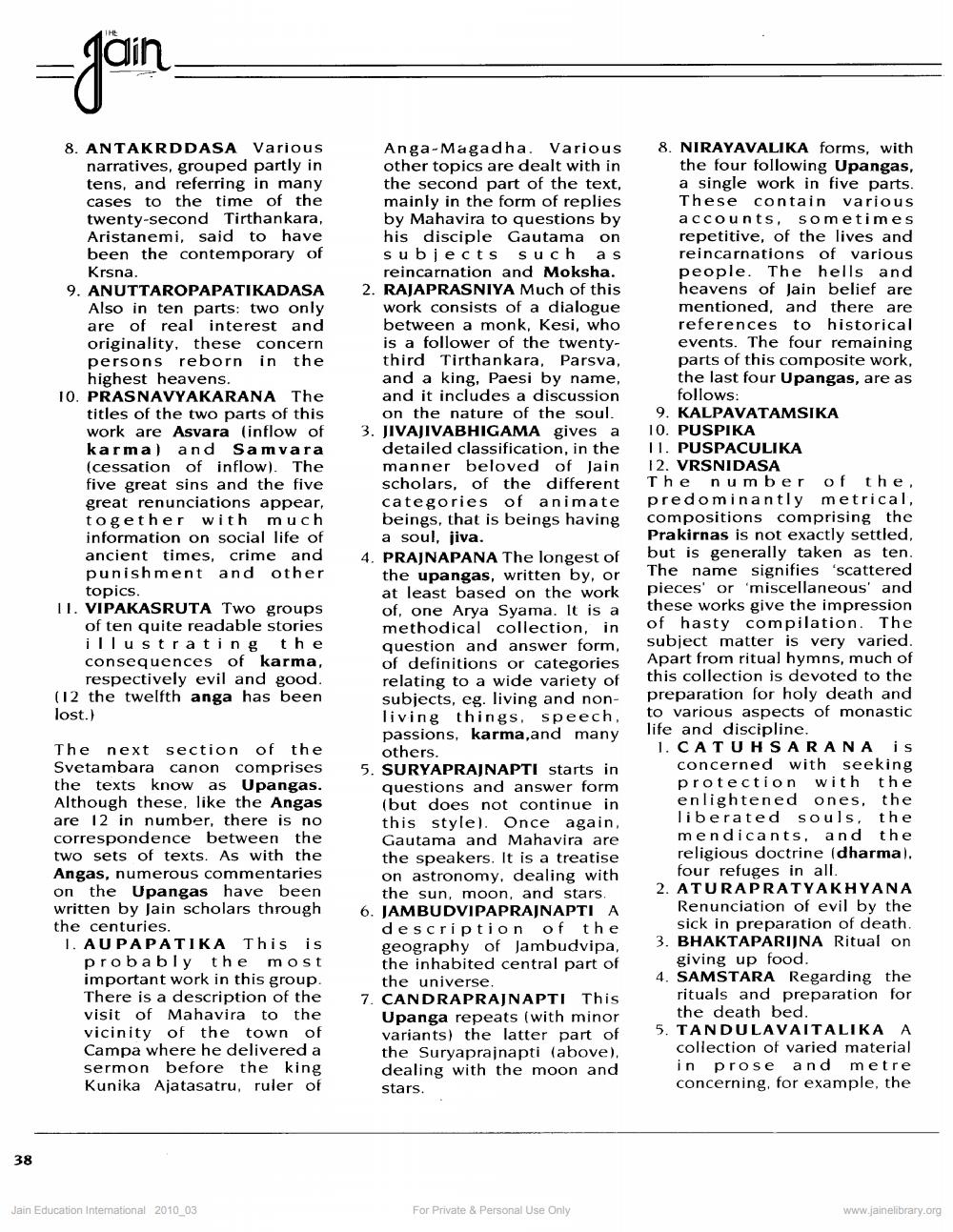________________
-Join
8. ANTAKRDDASA Various
narratives, grouped partly in tens, and referring in many cases to the time of the twenty-second Tirthankara, Aristanemi, said to have been the contemporary of
Krsna. 9. ANUTTAROPAPATIKADASA
Also in ten parts: two only are of real interest and originality, these concern persons reborn in the
highest heavens. 10. PRASNAVYAKARANA The
titles of the two parts of this work are Asvara (inflow of karma) and Samvara (cessation of inflow). The five great sins and the five great renunciations appear, together with much information on social life of ancient times, crime and punishment and other
topics. 11. VIPAKASRUTA Two groups
of ten quite readable stories illustrating the consequences of karma,
respectively evil and good. (12 the twelfth anga has been lost.)
Anga-Magadha. Various other topics are dealt with in the second part of the text, mainly in the form of replies by Mahavira to questions by his disciple Gautama on subjects such as
reincarnation and Moksha. 2. RAJAPRASNIYA Much of this
work consists of a dialogue between a monk, Kesi, who is a follower of the twentythird Tirthankara, Parsva, and a king, Paesi by name, and it includes a discussion
on the nature of the soul. 3. JIVAJIVABHIGAMA gives a
detailed classification, in the manner beloved of Jain scholars, of the different categories of animate beings, that is beings having
a soul, jiva. 4. PRAJNAPANA The longest of
the upangas, written by, or at least based on the work of, one Arya Syama. It is a methodical collection, in question and answer form, of definitions or categories relating to a wide variety of subjects, eg. living and nonliving things speech, passions, karma,and many
others. 5. SURYAPRAJNAPTI starts in
questions and answer form (but does not continue in this style). Once again, Gautama and Mahavira are the speakers. It is a treatise on astronomy, dealing with
the sun, moon, and stars. 6. JAMBUDVIPAPRAJNAPTIA
description of the geography of Jambudvipa, the inhabited central part of
the universe. 7. CANDRAPRAJNAPTI This
Upanga repeats (with minor variants) the latter part of the Suryaprajnapti (above). dealing with the moon and stars.
8. NIRAYAVALIKA forms, with
the four following Upangas, a single work in five parts. These contain various accounts, sometimes repetitive, of the lives and reincarnations of various people. The hells and heavens of Jain belief are mentioned, and there are references to historical events. The four remaining parts of this composite work, the last four Upangas, are as
follows: 9. KALPAVATAMSIKA 10. PUSPIKA 11. PUSPACULIKA 12. VRSNIDASA The number of the predominantly metrical, compositions comprising the Prakirnas is not exactly settled, but is generally taken as ten. The name signifies 'scattered pieces' or 'miscellaneous' and these works give the impression of hasty compilation. The subject matter is very varied. Apart from ritual hymns, much of this collection is devoted to the preparation for holy death and to various aspects of monastic life and discipline. 1. CATUHSARANA is
concerned with seeking protection with the enlightened ones, the liberated souls, the mendicants, and the religious doctrine (dharma).
four refuges in all. 2. ATURAPRATYAKHYANA
Renunciation of evil by the
sick in preparation of death. 3. BHAKTAPARIJNA Ritual on
giving up food. 4. SAMSTARA Regarding the
rituals and preparation for
the death bed. 5. TANDULAVAITALIKA A
collection of varied material in prose and metre concerning, for example, the
The next section of the Svetambara canon comprises the texts know as Upangas. Although these, like the Angas are 12 in number, there is no correspondence between the two sets of texts. As with the Angas, numerous commentaries on the Upangas have been written by Jain scholars through the centuries. 1. AUPAPATIKA This is probably the most important work in this group. There is a description of the visit of Mahavira to the vicinity of the town of Campa where he delivered a sermon before the king Kunika Ajatasatru, ruler of
38
Jain Education Interational 2010_03
For Private & Personal Use Only
www.jainelibrary.org




